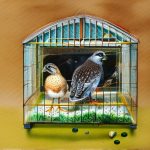Quail breeding cages are specially designed enclosures that are used to house and breed quail for commercial or personal purposes. These cages are typically made of wire mesh or plastic and are designed to provide a safe and comfortable environment for the quail to live and breed in. The cages are usually equipped with feeding and watering systems, as well as nesting areas for the quail to lay their eggs. Quail breeding cages come in a variety of sizes and designs, depending on the specific needs of the breeder and the number of quail being housed.
Quail breeding cages are an essential component of quail farming, as they provide a controlled environment for breeding and raising quail. The cages help to protect the quail from predators and other potential dangers, while also allowing the breeder to monitor the health and behavior of the birds. Additionally, breeding cages help to maximize space and efficiency, making it easier for breeders to manage and care for their quail. Overall, understanding the purpose and function of quail breeding cages is crucial for anyone looking to start a quail breeding operation.
Table of Contents
- 1 Choosing the Right Quail Breeding Cage
- 2 Setting Up Quail Breeding Cages in Canada
- 3 Maintaining Quail Breeding Cages
- 4 Ensuring the Health and Safety of Quail in Breeding Cages
- 5 Breeding Quail in Canada: Tips and Best Practices
- 6 Regulations and Guidelines for Quail Breeding Cages in Canada
- 7 FAQs
Key Takeaways
- Quail breeding cages should provide enough space for each bird to move comfortably and engage in natural behaviors.
- When choosing a quail breeding cage, consider factors such as material, size, and ease of cleaning and maintenance.
- Setting up quail breeding cages in Canada requires attention to temperature, ventilation, and protection from predators.
- Regular cleaning, disinfection, and monitoring of quail breeding cages are essential for maintaining a healthy environment.
- Ensuring the health and safety of quail in breeding cages involves providing proper nutrition, monitoring for signs of illness, and preventing overcrowding.
Choosing the Right Quail Breeding Cage
When it comes to choosing the right quail breeding cage, there are several factors to consider. The size of the cage is one of the most important considerations, as it will determine how many quail can be housed in the cage and how much space they will have to move around. Additionally, the material of the cage is important, as it will affect the durability and longevity of the cage. Wire mesh cages are popular for their durability and ease of cleaning, while plastic cages are lightweight and easy to move.
Another important consideration when choosing a quail breeding cage is the design and layout of the cage. The cage should be equipped with feeding and watering systems that are easily accessible to the quail, as well as nesting areas for the birds to lay their eggs. The cage should also be designed to provide adequate ventilation and protection from the elements. Overall, choosing the right quail breeding cage is essential for creating a safe and comfortable environment for the quail to breed and thrive in.
Setting Up Quail Breeding Cages in Canada
Setting up quail breeding cages in Canada requires careful planning and consideration of local regulations and guidelines. Before setting up a quail breeding operation, it is important to research and understand the specific requirements for housing and breeding quail in Canada. This may include obtaining permits or licenses, as well as adhering to certain standards for cage size, design, and sanitation.
Once all necessary permits and approvals have been obtained, setting up quail breeding cages in Canada involves selecting an appropriate location for the cages, ensuring that they are protected from predators and extreme weather conditions. The cages should be set up in a way that allows for easy access for feeding, watering, and cleaning, as well as monitoring the health and behavior of the quail. Additionally, it is important to ensure that the cages are equipped with proper ventilation and lighting to create a comfortable environment for the quail.
Maintaining Quail Breeding Cages
Maintaining quail breeding cages is essential for ensuring the health and well-being of the quail. Regular cleaning and sanitation of the cages is crucial for preventing the spread of disease and maintaining a healthy environment for the birds. This may involve removing waste and soiled bedding on a regular basis, as well as disinfecting the cages to eliminate bacteria and parasites.
In addition to cleaning, maintaining quail breeding cages also involves monitoring the condition of the cages and making any necessary repairs or upgrades. This may include replacing worn or damaged parts, such as wire mesh or feeding systems, as well as ensuring that the cages are secure and predator-proof. Regular maintenance of the cages will help to prolong their lifespan and ensure that they continue to provide a safe and comfortable environment for the quail.
Ensuring the Health and Safety of Quail in Breeding Cages
Ensuring the health and safety of quail in breeding cages is a top priority for any quail breeder. This involves providing a clean and comfortable environment for the quail to live in, as well as monitoring their behavior and health on a regular basis. It is important to provide a balanced diet for the quail, including a mix of commercial feed and fresh greens, as well as access to clean water at all times.
In addition to proper nutrition, it is important to monitor the quail for signs of illness or injury, and to provide prompt medical attention when necessary. This may involve working with a veterinarian who is experienced in treating quail, as well as having a basic understanding of common health issues that can affect quail. Overall, ensuring the health and safety of quail in breeding cages requires diligence and attention to detail, but is essential for successful breeding and raising of healthy quail.
Breeding Quail in Canada: Tips and Best Practices

Breeding quail in Canada requires careful planning and attention to detail in order to be successful. It is important to select healthy breeding stock from reputable sources, as well as to provide a suitable environment for breeding. This may involve providing nesting areas within the breeding cages, as well as monitoring the behavior of the birds for signs of mating and egg-laying.
In addition to providing a suitable environment for breeding, it is important to have a plan for managing the eggs and chicks that are produced. This may involve collecting and incubating eggs, as well as providing proper care for newly hatched chicks. It is also important to have a plan for managing surplus birds that are produced through breeding, whether through selling them or integrating them into existing flocks.
Regulations and Guidelines for Quail Breeding Cages in Canada
In Canada, there are specific regulations and guidelines that govern the housing and breeding of quail. These regulations may vary by province or territory, so it is important to research and understand the specific requirements for quail breeding in your area. This may include obtaining permits or licenses for housing quail, as well as adhering to certain standards for cage size, design, and sanitation.
In addition to local regulations, there may also be industry standards or best practices for housing and breeding quail that should be followed. This may include guidelines for cage size and design, as well as recommendations for feeding, watering, and monitoring the health of the birds. Overall, understanding and adhering to regulations and guidelines for quail breeding cages in Canada is essential for operating a successful and compliant quail breeding operation.
If you’re considering quail breeding cages in Canada, you may also be interested in learning about different housing options for chickens. PoultryWizard.com offers a helpful article on A-Frame Chicken Coops, which can provide valuable insights into creating suitable living spaces for your poultry. Understanding the various coop designs and their benefits can help you make informed decisions when setting up your quail breeding operation.
FAQs
What are quail breeding cages?
Quail breeding cages are specially designed enclosures used for housing and breeding quail. These cages are typically equipped with features to provide a suitable environment for quail to lay eggs, incubate them, and rear their young.
What are the benefits of using quail breeding cages?
Quail breeding cages provide a controlled environment for breeding, which can help to increase the success rate of hatching and rearing healthy quail chicks. They also make it easier to monitor and manage the breeding process, as well as provide protection from predators and other environmental factors.
What features should I look for in quail breeding cages?
When choosing quail breeding cages, it’s important to consider factors such as size, ventilation, ease of cleaning, and durability. Additionally, features such as removable dividers, egg collection trays, and adjustable height platforms can be beneficial for managing the breeding process.
Where can I find quail breeding cages in Canada?
Quail breeding cages can be found at specialty pet stores, agricultural supply stores, and online retailers that cater to poultry and game bird enthusiasts. It’s important to ensure that the cages meet the specific needs of quail breeding and are suitable for the Canadian climate.
Are there any regulations or guidelines for quail breeding cages in Canada?
In Canada, there may be regulations and guidelines set by local authorities or agricultural agencies regarding the housing and breeding of quail. It’s important to research and comply with any relevant regulations to ensure the welfare of the quail and adherence to legal requirements.
Meet Walter, the feathered-friend fanatic of Florida! Nestled in the sunshine state, Walter struts through life with his feathered companions, clucking his way to happiness. With a coop that’s fancier than a five-star hotel, he’s the Don Juan of the chicken world. When he’s not teaching his hens to do the cha-cha, you’ll find him in a heated debate with his prized rooster, Sir Clucks-a-Lot. Walter’s poultry passion is no yolk; he’s the sunny-side-up guy you never knew you needed in your flock of friends!







